
Diese Seite auf deutsch  (wird's wahrscheinlich nicht geben)
(wird's wahrscheinlich nicht geben)
Measuring the Sun's position above the horizon
Examples and Impressions
Some project day impressions of participants
Amman, Jordanian Astronomical Society
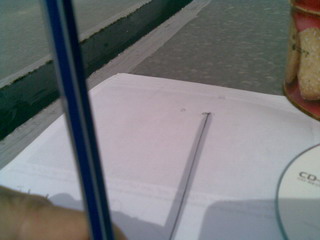
"Dear sir ,
I would like to say that it was a great chance to make this trial to measure the radius of the Earth. Thanx alot for your effort.
I'm Basma from Amman, Jordan . I participated in this experiment but I note that "The dots mark the positions of all sites taking part in this project" did'nt show Jordan . I note also that Muscut , Oman near the Arab Gulf doesn't appear in your map although my friends there participated in the event . will you pleaze modify the map.
Thanx again and looking forward another great event .
Regards ,
Basma (Jordanian Astronomical Society)
Bamberg, Germany
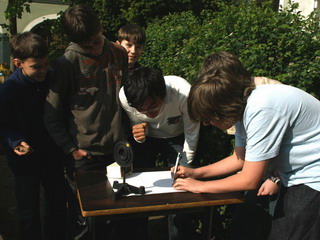
(Astro. AG Clavius-Gymnasium, Bamberg, no email contact)
Bangi, Malysia
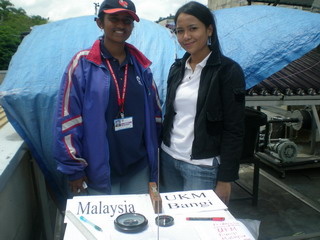
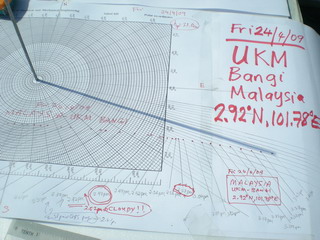
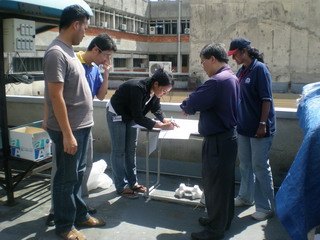
"Dear Prof. Dr. Udo Backhaus and Prof. Dato' Dr. Baharudin Yatim,
Our measurement team comprises of me as the leader and two of my physics MSc students - Miss Juliah Theyirakumar and Miss Puteri Noor Safura Megat Mahmud. We are at the School of Applied Physics and The Institute of Space Science at Universiti Kebangsaan Malaysia (National University of Malaysia). Our university is located in the town of Bangi, about 30 km south of Kuala Lumpur, the capital city of Malaysia. Observations were done at the rooftop of our physics building with true north-south determination and trial runs started in late March 2009. However, I only registered our team at the eleventh hour, last night in fact.
This measurement of Earth radius is a worldwide programme that is part of IYA2009 - the International Year of Astronomy. I am happy to inform that our measurements produce the Earth radius of 6370.9 km, which is quite reasonable for our location at the equatorial bulge with coordinates of 2.92 deg N, 101.78 deg E and elevation 48 m. (These coordinates were estimated from Google Earth and verified by a GPS device.) From the data upload website I note that we were the ninth team in the world to submit the result for the 6.47 UT measurement with Bangalore, India as the sub-solar point (at 12.93 deg N and 77.79 deg E). However, it seems that a few earlier teams did not get the expected range of 6300-6400 km for the Earth radius. I am sorry that I submitted twice the data set as I forgot to put Malaysia or our institution name in the respective location and observer columns of the first submission.
If requested I can email our more complete data set, analysis and pictures of our measurements and equipment setting. As illustrations, I'm attaching two of our observation pictures - gnomon setup with student experimenters and actual measurements including that at the zero hour of 6.47 UT (14.47 MYT). But please be warned - these JPG files are about 2 MB, so they might not be able to be delivered by a recipient's email system.
Thank you Prof. Backhaus for providing us the chance to participate in this global event of astronomy. The information and guidance you gave on your website really helped in the implementation of the project. How I wished I have participated in the Venus 2004 transit project.
Yours sincerely
Dr. Geri Gopir" (School of Applied Physics, Faculty of Science and Technology, Universiti Kebangsaan Malaysia, 43600 Bangi, MALAYSIA
Beograd, Serbia
"Die "Belgrader" sind bereit! Meßplatten vorbereitet, Meßteams informiert, ausgebildet und eingeteilt. Haben gestern (Sonntag) mal "vorgemessen" bei super Sonnenschein. Leider ist es hier heute zu 8/8 bewölkt mit einer hohen Wolkendecke, aber wir nehmen an Messungen mit, was wir bekommen können. Die Ergebnisse erhalten Sie dann über den Kurierdienst des Auswärtigen Amtes über die deutsche Botschaft Belgrad. (March 23th. On that day, the sun in Essen and in Istanbul where simultaneous measurements were planned the sun was completely unvisible!)
...
Der Meßtag ist herum, leider nur zwei Messungen, die auch nicht bei klarer Sonne, sondern bei hoher Cirrenwolkendecke.
Schade!
Wir sind aber bereit, die Veranstaltung - auch kurzfristig- zu wiederholen.
Mit freundlichen Grüßen
Dieter Ziemann" (Schulleiter, Deutsche Schule, Belgrad)
Craiova, Romania
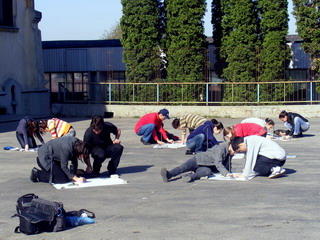
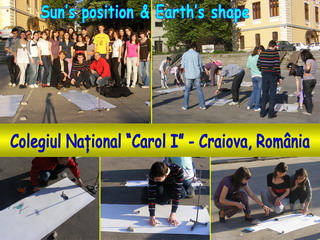
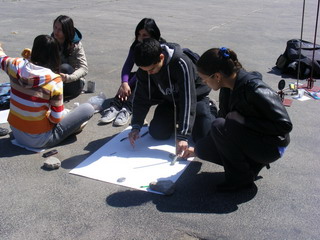
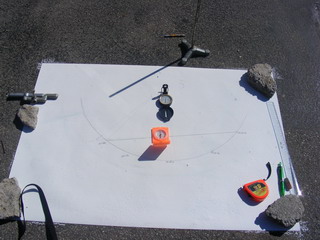
Determining the north-south direction
"Sehr geehrter Herr Professor Udo Backhaus,
Wir haben den Versuch in sehr guten Bedingungen (sonniges Wetter) und mit gutem Ergebnis (Erdradius 6341,075 km) durchgefuehrt. Wir haben in 8 Gruppen von Schueler gearbeitet, also 8 Werte ermittelt und am Ende haben wir die durchschnitlichen Werte gerechnet, die wir in die Webseite geschrieben haben.
- Wir haben unsere Ergebnisse in die Webseite des Projektes leider zweimal geladen, denn unser Foto wurde nicht gleichzeitig mit den restlichen Daten angezeigt, und wir haben geglaubt dass Probleme mit dem Namen unseres Fotos waren.
- Normalenweise kann man in die Webseite nur ein einziges Foto laden, oder ist es moeglich auch mehrere Fotos? Kann man auch Texte (Impresionen) einladen oder nur Fotos ?
- Ein Missverstaendnis habe ich doch betreffs Azimutes. Also wir haben ein Winkel zwischen Schatten und die Richtung nach Norden von 82,41 Grad ermittelt(Schatten links von der Richtung nach Norden, also Stabschatten in 4-ten Quadrant ). Ich habe das Azimut in die Tabelle als " - 82,41" geschrieben, denn ich habe gedacht dass die Richtung des Schattens links von Nordrichtung zeigt. Ich weiss noch nicht aber ob ich gut geschrieben habe. Wenn nicht, bitte ich Ihnen unser angezeigtes Azimut in die Tabelle korigierren.
- In der Liste (pdf) der Teilnehmer zu diesem Sonnenprojekt ist leider der Name unseres Gymnasium falsch geschrieben Carol II statt " Carol I " wie richtig ist.
- Noch ein Fehler der jemandem Missverstaendnisse bringen kann, habe ich bemerkt an der Seite http://www.astronomie-und-internet.de/IYA2009/sun/inscribe1556.htm Der sub-solar Ort ist falsch geschriebenen "sub-solar point (south von Hawaii)" statt "sub-solar point (Bridgetown)", obwohl die geographischen Koordinaten richtig sind.
Mit meinen Schüler gemeinsam, haben wir am Donnerstag, den 23 April (den Tag vor dem Versuch) die Nord-Südrichtung bestimmt, genau entsprechend dem Verfahren in http://www.didaktik.physik.uni-due.de/IYA2009/IYA2009-Schattenstab.html beschrieben.
Ich werde Ihnen auch einige Fotos als Beweis dafür schicken. Wir hatten dann einen Winkel zwischen magnetische Norden und genaue Nord-Südrichtung von etwa 5 Grad gemessen, mit korrektem Position der magnetische Nordrichtung (rechts von geographischen Nordrichtung, im Uhrzeigersinn). Nach einer 4-Stunden Beobachtung haben wir 13,23 (lokale Zeit) oder 10,23 UT als Mittagszeit bestimmt und auch einen Höhenwinkel der Sonne von 57,62 Grad ermittelt. Diese Werte führen für Craiova zu einer geographischen Länge von 44.71 Grad N und zu einer Breite von 24,25 Grad. (Ich habe eine Deklination der Sonne von +12.33 Grad für den 23-ten April wahr genommen.). Ich schicke Ihnen jetzt diese Daten auch als einer Noon Measurements Tabelle.
Herzlichen Gruesse aus Craiova
Liviu Ionescu" ("Carol I" Gymnasium in Craiova, Rumänien)
Damascus, Syria
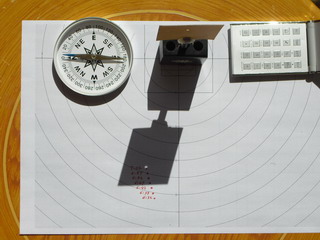
"Dear Mr. Prof. Backhaus..
We would like to thank you very much for this opportunity to measure the earth’s radius..
We tried in Syria to take the measurement in five cities.. but according to weather conditions the sun was only visible in two cities at the T0 timing.. Damascus and Aleppo.. we have submitted our results although it seems that we needed more precision in the whole process.. I would also like to thank you very much for the impressions page, which clearly reflect the whole thing.. of course you have the full permission to use our shots and comments..
We strongly support the repetition of the experiment in later date.. the members of our association in other cities where it was cloudy were very disappointed and they will be so eager to repeat it.. one of them has even printed the diagram on a 2-meter paper in order to be precise, but the weather was against him! We may also convey this experiment to one school were pupils can also participate in taking the measurements..
So we are waiting for you to determine a second date for this experiment..
With our deep respect..
Dr. Firas Safadi" (Syrian Astronomers Association, Damascus, Syria. On the syrian IYA2009-page, you can find a short participation report in Arabian.)
Dillingen, Germany
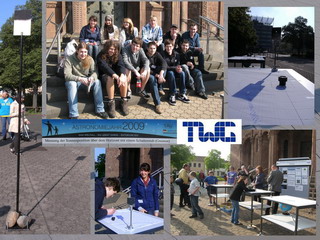
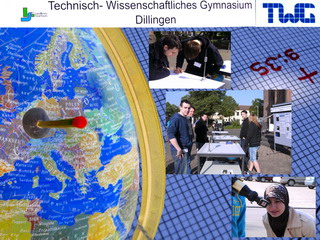
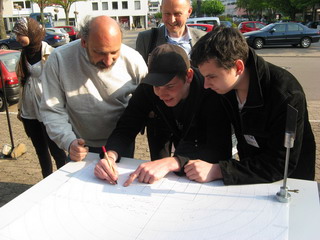
Essen, Germany
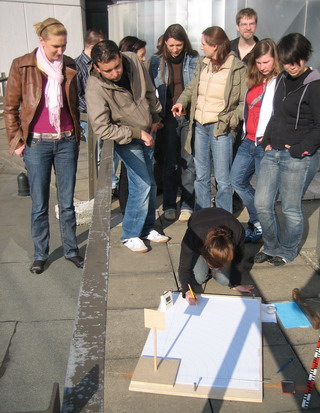 |
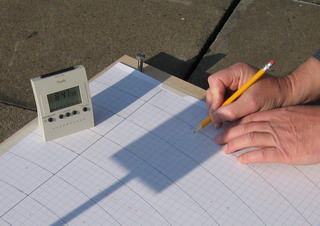 |
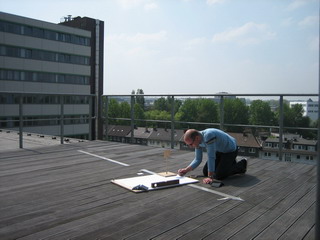 |
| Common morning measurement |
The critical moment |
Lonesome afternoon measurement |
We prepared our measurement since March, examined a suitable length of the gnomon and determined the north-south-direction at two different places (for morning and afternoon observations) carefully by noon measurements.
After two dusty and cloudy days on April 22nd/23rd, the weather was nearly perfect. The 6:47-measurement (early in the morning in Germany) was done by a group of students, the noon observations at both places by my colleagues and myself and, finally, the afternoon measurement by Thomas Braun alone (while I was a studio
guest in a broadcasting project feature).
Additional images can be found here.
Udo Backhaus (Physics Department, University of Duisburg-Essen, Germany)
Hanau-Großauheim, Germany
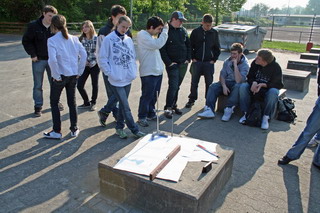
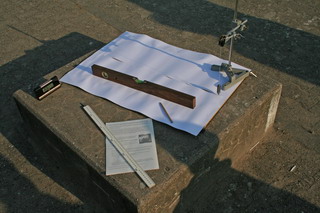
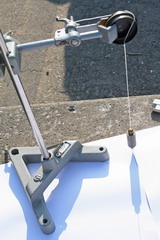
"Hallo!
Als Anlage noch zwei zusätzliche Bilder von unserer Messung (Lindenauschule, Hanau-Großauheim, Wahlpflichtkurs Astronomie).
Wie man sieht, hatte sich das Papier, das wir vorher auf ein Brett geklebt hatten, durch Temperatur- und Feuchtigkeitsschwankungen etwas gewellt. Das hat die Messung zwar etwas erschwert, aber es ließ sich gut korrigieren.
Ein größerer Fehler ist bei der Ermittlung des Abstandes zum subsolaren Punkt passiert: Aus Versehen hatten wir zunächst bei der geografischen Länge von Bangalore West statt Ost eingegeben und dadurch einen über 1000 km zu großen Wert erhalten. Nach der Eliminierung dieses Fehlers sind wir aber jetzt mit unserem Ergebnis sehr zufrieden. Durch diesen Fehler bedingt haben wir unsere Ergebnisse zweimal übermittelt; das erste (falsche) könnten Sie im Grunde wieder entfernen.
Viele Grüße
Hans Joachim Wenzel" (Astronomiekurs, Astronomiekurs, Lindenauschule, Hanau-Großauheim)
Höflein, Austria
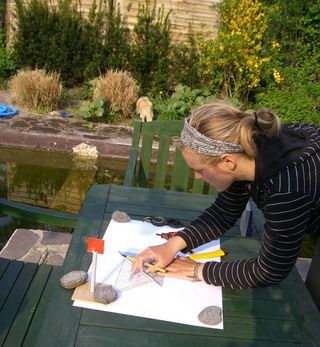
"Sehr geehrter Herr Prof. Backhaus!
Nach Vermeidung von ö und / konnte ich dann sofort die Daten übermitteln. Leider habe ich bei der 6:47 Eingabe einen Tippfehler gemacht und habe anstatt der richtigen 6842 km nur 3842 km bei der Entfernung zum subpolaren Punkt eingetragen. Könnten Sie diese Eingabe bitte korrigieren?
Quellwolken zur Mittagszeit haben leider die Nord-Süd Richtungs Optimierung verhindert.
Vielen Dank für das tolle Projekt!
Mit freundlichen Grüßen,
Martin Brodicky" (Freie Astronomen Höflein, Österreich)
Isfahan, Iran
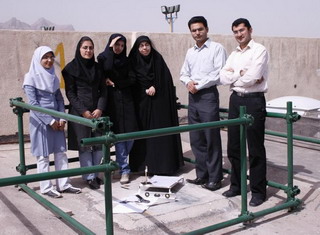
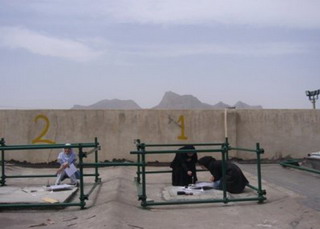
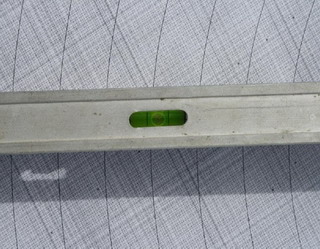
"Dear Sir.
I'm sorry about late to send the report, unfortunately here it was a local problem of network Internet lines these recent days.
We make a table of the parameters which we knowed of the link of project, and edit it as a "pdf" and "Word" file in attachment.
I hope that would be useful.
Best regards.
Ehsan Ranaei." (Adib Astronomy Center, Isfahan, Iran)
Istanbul, Turkey
"Sehr geehrter Herr Backhaus,
obwohl wir die Daten noch nicht eingetragen haben waren wir erfolgreich - genau am Messpunkt schien die Sonne. Die Auswertung wird von Schülern übernommen und die haben in der Türkei an den Wochenenden keine Zeit - dann sind die Termine für die Paukschulen zu den zentralen Universitätseingangsprüfungen. Ich konnte am WE auch nicht einspringen, da mich dienstliche Angelegenheiten nach Ankara gerufen haben.
Ich denke dass auch Istanbul die Ergebnisse innerhalb der nächsten zwei Tage eintragen kann.
Vorab die Messwerte: h= 16,2; A = 62,8
Viele Grüße vom Bosporus
Rolf Schell" (Istanbul Lisesi)
Kingston, Jamaica (very close to our 15:56 sub-solar point!)
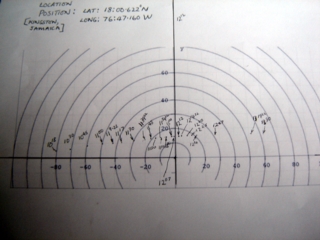
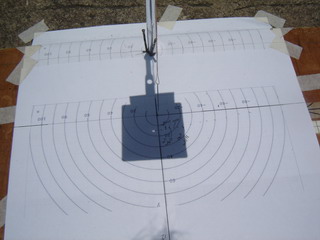
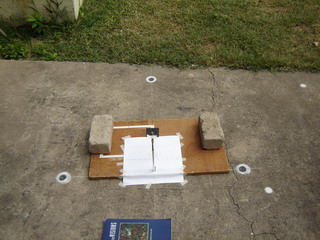
"Dear Professor Udo,
I had written to Anne Hager on the run up to the 24th. Measurements,I must mention that our team was Bobby Rodriques, Cleveland Gustard, and I.. We met at Bobby's House where he has the Patio Floor marked for his telescope legs which is in perfect alignment with the North Star and the floor in level This can be seen in picture attached. Because we are so near to the mid-day sun at the zenith,(approximately 5.5 degrees) we could not use the Pencil point or the the pinhole vertically, so what we did, was to set the pinhole horizontally using a needle and thread to plumb it through the pin hole.
We are very happy to tell you that the only 2 days of good sunlight we had was on the 23rd and the 24th. and we are pleased with the results we got when the Midday sun hit the lines at exactly 8 minutes after 12.00 noon local time.This Bobby accounted for by calculation of the Equation of time.
We hope to use this set up again For the students of Campion College to mark the charts with the the shadow as it reaches the 18.00 deg Declination mark.
we enjoyed doing this project and look forward to working out the radius from different measurements. Thanks for the opportunity to participate
Errol Rickman" (President of the Astronomical Association of Jamaica)
Lippstadt, Germany
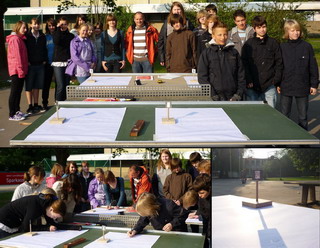
"Hallo Herr Backhaus,
das hat ja wunderbar funktioniert. Eas ist ein toller Erfolg. Nun sind ja schon viele Ergebnisse eingetragen worden.
Das Verfolgen des Sonnenabbildes hat die Schüler fasziniert. Dass das Bild so schnell wandert
konnten sie kaum glauben. Man kann viel erzählen, aber erst das tatsächliche Erleben des Fänomens
ist sehr einprägend und überzeugend.
Leider hatten wir große Probleme bei der Ausrichtung unserer Datenblätter. Am Mittwoch (Tag der Generalprobe) zeigte sich die Sonne leider nicht. Es ging uns nicht besser als Ihnen, beim ersten Test in Essen.
Am Donnerstag sollte dann die Mittagslinie über den Lauf der Sonne bestimmt werden. Doch an diesem Tag war ja das Wetter noch schlechter.
Am heutigen Morgen konnten wir jedoch aufatmen. Bei strahlendem Sonnenschein machte den Schülern das Nachzeichnen der Bahn richtig Spaß. Mit einem Kompass legten wir dann die N-S-Richtung fest. Leider etwas ungenau. Wir werden nächsten Mittwoch bei der Auswertung im Astrokurs diesen Teil noch einmal genau nachholen (die Tischtennisplatten stellt ja keiner um).
Ich werde einige Bilder auf unserer Homepage hinterlegen und Ihnen dann einen Link zusenden.
Ihnen ein schönes Wochenende und noch viele Daten von den weiteren Terminen.
Viele Grüße
Ronald Schünecke, (Astronomiekurs EG, Lippstadt)
Muscat, Oman
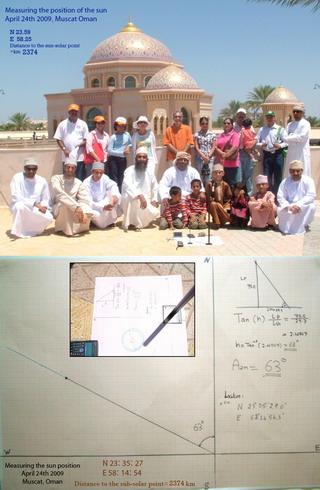
"Dear Sir,
Could you kindly delete the first enrty I entered this morning? the distanse to the sub-solar was not correct. and the radios of earth became 3338.8 km accordingly.
Many thanx:)
Marwan Shwaiki" (Oman Astronomical Society)
Recklinghausen, Germany
 |
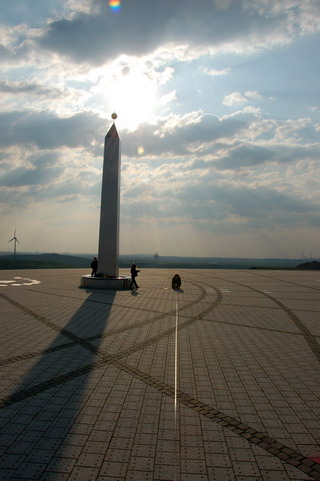 |
| Morning measurement | Afternoon measurement |
"Lieber Herr Backhaus,
die Messung heute morgen ging gut, allerdings schaffe ich es nicht mehr, die Daten einzugeben, da Uwe momentan in einer nicht geplanten Besprechung sitzt und ich gleich die Kinder abholen muss. Wir geben dann alles heute abend ein.
Mittagszeitpunkt war nach meiner Messung auf der Halde 13.31 Uhr.
Das Wetter spielt ja richtig gut mit:-)
Gruss
Anne Hager" (Physics Department, University of Duisburg-Essen, Germany)
(Anne Hager and her husband, Uwe Walther, performed the large scale measurements on the Halde Hoheward.)
Silistra, Bulgaria
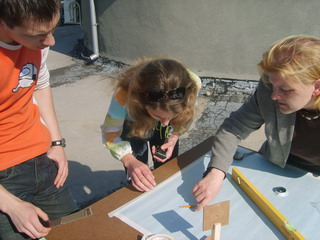
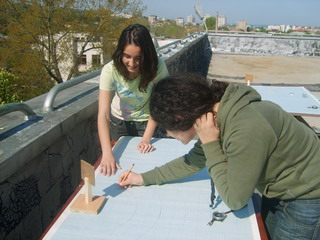
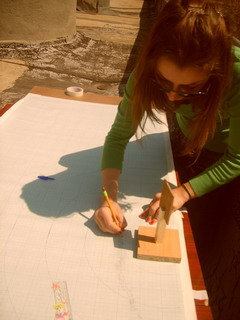
"Sehr geehrter Prof. Dr. Udo Backhaus
Ich bin Schülerin am Fremdsprachengymnasium "Pejo Yavorov" in Silistra, Bulgarien. Vor zwei Wochen hat unsere Schule einen Brief von Ihnen bekommen im Zusammenhang mit dem Projekt für die Beobachtung des Bewegens von Sonne und Mond Ende April und Mai. Unsere Schule möchte an diesem Projekt teilnehmen.
...
Wir haben schon die Resultaten geschickt und ich hoffe, dass die nützlich werden.
Mit freundlichen Grüßen,
Lora Abed Al-Wahab" (Fremdsprachengymnasium "Pejo Yavorov", Silistra, Bulgaria)
Sohland, Germany
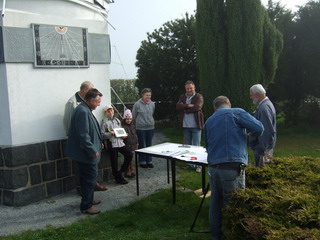
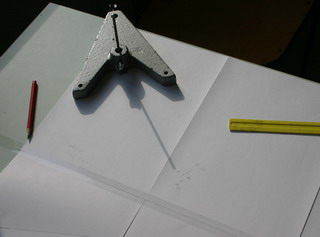
"Sehr geehrter Herr Prof. Backhaus,
nochmals vielen Dank für die hervorragende Unterstützung und Begleitung von Ihrer Seite bei diesem interessanten und faszinierenden Projekt. Sowohl für die Sternfreunde der Sternwarte Sohland/Spree als auch für die Schüler des LK Physik 11 am Immanuel-Kant-Gymnasiums Wilthen war es ein besonderes Erlebnis, weltweit gleichzeitig an einer astronomischen Beobachtung teilzunehmen.
Wettermäßig hatten wir dahingehend das Glück, dass sich pünktlich bis zur Messung 6:47 UT der Nebel auflöste und die Schattenspitze messbar war. In der Schule bereitete uns das Finden der Nordrichtung größere Schwierigkeiten als gedacht, die Werte für das Azimut sind daher stark fehlerbehaftet.
Sternfreunde, Schüler und Lehrer freuen sich jetzt auf das Mondprojekt Ende Mai.
Mit freundlichen Grüßen
Dirk Irrgang" (Sternwarte Sohland/Spree, Germany)
Teheran, Iran
k.jpg)
k.jpg)
Unfortunately, only trial but no performance!
"Lieber Herr Prof. Backhaus,
leider hatten wir nicht so viel Glück wie die Messgruppe in Essen. Heute war das Wetter in Teheran so stark bewölkt und verhangen, dass es nur diffuses Licht gab und überhaupt kein Schatten zu sehen war. So können wir leider kein Messergebnis beisteuern, aber zwei Fotos. Damit die Enttäuschung nicht zu groß wird, sind wir kurz nach 12 Uhr nach abgebrochener Messung dann zum "Star Burger" gegangen und haben wenigstens zusammen was gegessen.
Die Vorbereitungen haben aber auch viel Spass gemacht und wir haben auch was gelernt. Gerne machen wir wieder mal mit bei den astronomischen Projekten.
Viele Grüße aus dem trüben Teheran
Fatima Chahin-Dörflinger" (Deutsche Botschaftsschule, Teheran, Iran)
Villa Ballester, Argentina
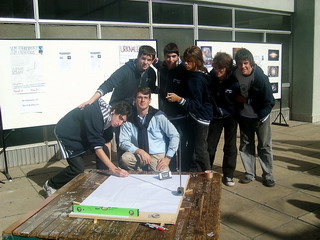
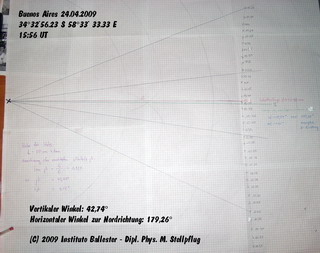
"Hallo Herr Backhaus,
Buenos Aires hat die Daten gerade eben hochgeladen. Die Messung war
erfolgreich. Die halbe Schule hat sich die Ausstellung angesehen und das
Experiment. Eine tolle Idee!
Zur Sicherheit schicke ich ihnen noch das Blatt mit allen Daten
inklusive der Auswertung. Das typische Bild, dass Sie haben wollten,
habe ich über die Webseite hochgeladen.
Wir sind gespannt, was sie mit den Daten machen.
Grüße von der Südhalbkugel,
Michael Stellpflug" (Instituto Ballester, B1653LXJ Villa Ballester,
Prov. Buenos Aires, Argentina)
Wilthen, Germany
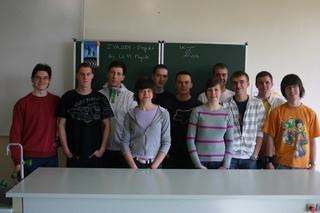
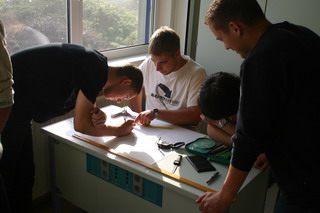
(no email contact)
Preparation: The Obelisk on the "Halde Hoheward" in Recklinghausen, Germany
The horizontal sundial on Halde Hoheward with its obelisk as a shadow caster is optimally appropriate to perform our experiments on a large scale. We visited it on March 21rst and determined the actual value of the equation of time by observing exactly the time at which the shadow crossed the noon line (12:37:54 MEZ). With the exact longitude of the dial which is given on a display board (λ=7°10'11.5") we got eot=6m27s. (The exact value was 6m31s!)
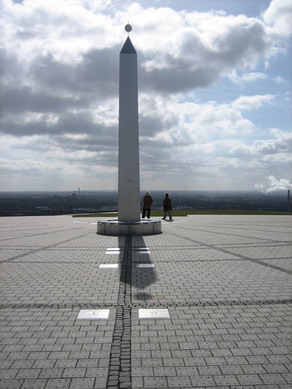 |
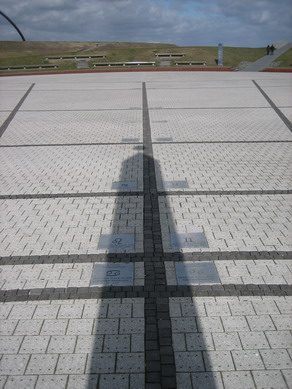 |
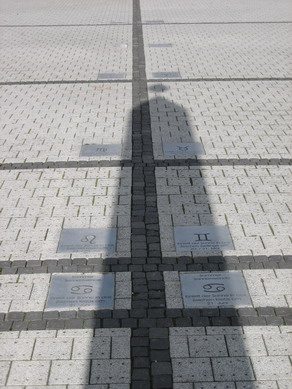 |
| The oblisk and its shadow |
just before noon |
just after noon |
In case of sunny weather on April 24th, some of our partners will perform our measurements on a large scale.
The north-south-direction and our own geographical position
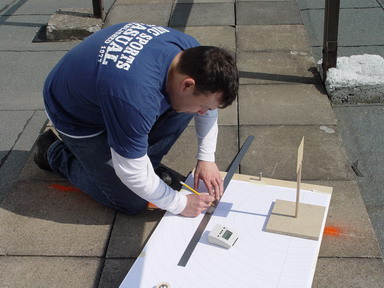 |
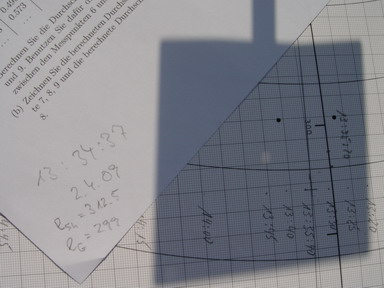 |
Registering the noon position of the shadow.
The line from north to south is already fixed. |
Noon results of April 2nd |
The first spring days at the beginning of April gave us the possibility of exercising and improving our procedures and of finding the exact northern direction. With our noon results of April 2nd which can be read in the right picture above (and knowing the eot and the sun's declination of that day), we determined our geographical position. Our result: φ=51.6°, λ=6.8°. (Our GPS states as the correct position: φ=51°27.839'=51.434°, λ=7°0.240'=7.00°.)

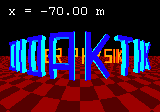
 Udo Backhaus
Udo Backhaus

last change: last update: 2020-03-03


 (wird's wahrscheinlich nicht geben)
(wird's wahrscheinlich nicht geben)









k.jpg)
k.jpg)







 Udo Backhaus
Udo Backhaus
